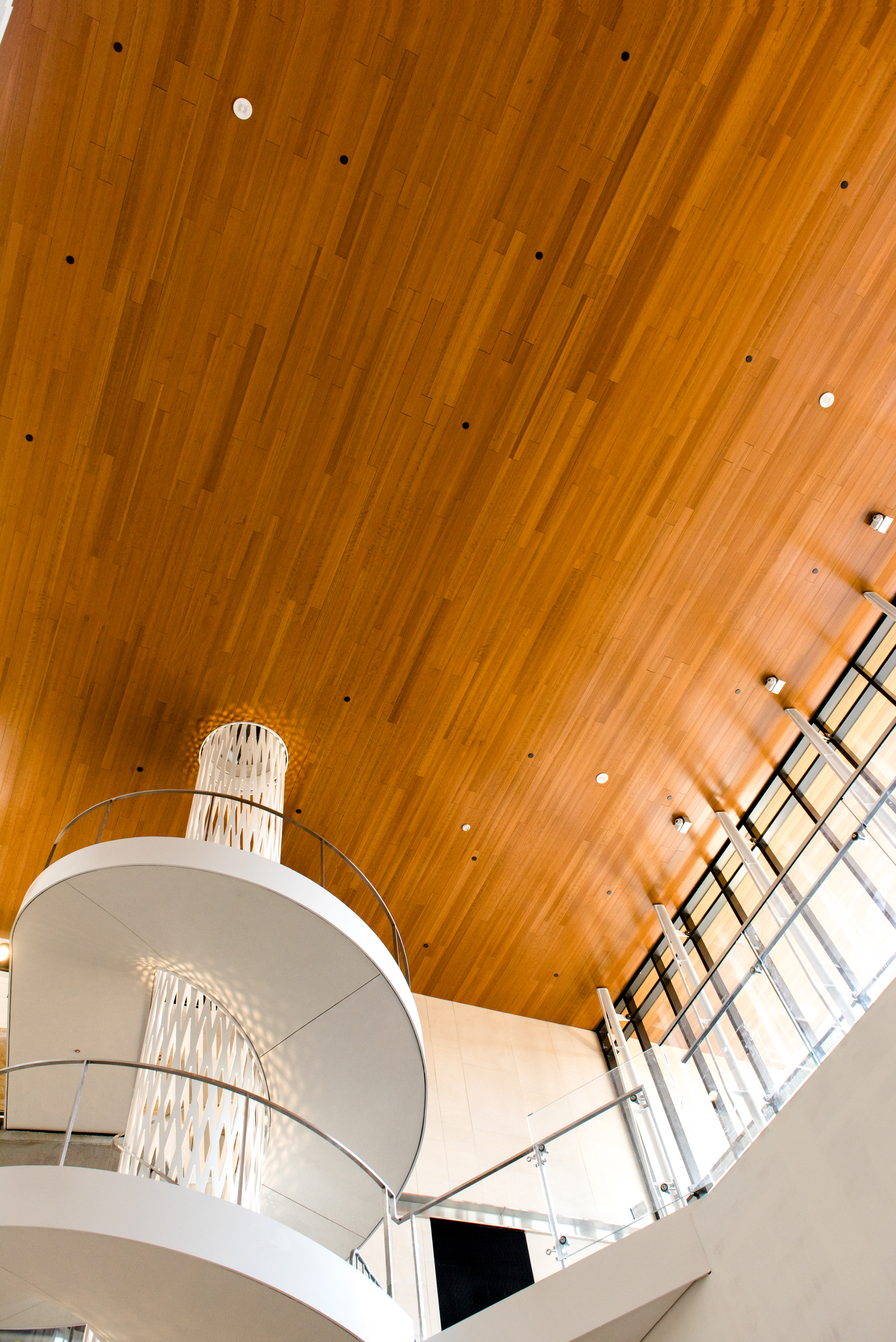
Inside the bright, bustling atrium of the EERC, there is one feature that stands out from the rest. It reflects a unique blend of form and purpose—of simplicity and complexity—and serves as a functional art installation that symbolizes the building’s charisma and character. The story of the S.P. Yates Staircase, which begins in New York, continues in Europe and ends in Texas, is a tale of novel design, shrewd problem solving and international collaboration.

The Concept
Envisioned to be the anchor that ties three floors together within the atrium and connects the Schlumberger Center for Student Organizations with the lounges of the Mundkur E-Loft, the staircase was designed by NYC-based Ennead Architects to inspire engineering teaching moments in the building. They began by exploring different shapes and patterns for the steel frame around which the stairs would wrap. By creating models out of paper, the team was able to produce an assortment of styles that could be analyzed and scaled to assess feasibility at actual size.

The Fabrication
Creating a miniature model out of paper is one thing. Rolling up and perforating a 45-foot-long steel plate is another. After tweaking and finalizing the design to meet code, project partners Jacobs Engineering Group, Hensel Phelps, Datum Engineers and Big D Metalworks collaborated to find the optimal solution to construct the central column.
They found it halfway around the world.
Because of the column’s size (over 10,000 lbs.) and the complexity of its diamond-shaped pattern—which was designed to appear more compact and weight-bearing at the bottom and sparser at the top—there were few fabricators that could construct it with a high degree of precision. After months of research and meetings with potential shops, Big D contracted with Netherlands-based Plaatwalserij Purmerend to produce the cylindrical column and HGG Profiling Specialists, also based in the Netherlands, to cut the material. The column was then placed in a crate and shipped across the Atlantic to the Port of Houston.
The Installation
On American soil for the first time , the column was loaded onto a truck in Houston and transported to Big D’s facility in Dallas, where it was hand-ground for smoothness and prepared for final completion. It was then transported to the EERC construction site at the corner of San Jacinto Boulevard and Dean Keeton Street.
Lifted high into the air and meticulously placed through a hole intentionally left unfinished in the atrium roof, the column was bolted to the floor, primed and painted and prepped for installation of the handrail, curved-glass outer guardrail and treads and risers. After six years of planning, dozens of design evolutions, hundreds of meetings and conversations and thousands of miles traveled, the EERC’s iconic spiral staircase was finally home.
The Visionary
Like most extraordinary structures, the EERC spiral staircase needed an extraordinary investor to help make it a reality. Enter Peyton Yates, Texas Engineering alumnus and energy industry leader for over four decades, who believes that great buildings need great artwork to inspire future generations.
Yates, who lives in Artesia, New Mexico, earned both his bachelor’s and master’s degrees in petroleum engineering from UT Austin. He began his career with Chevron before joining his family’s business in 1970 and ultimately rising to be president of Yates Drilling Company and president of Yates Petroleum Corp.
As a philanthropist and civic leader, Yates has been equally influential. He has served as president of the New Mexico Academy of Science, the Independent Petroleum Association of New Mexico and the Boy Scouts of America Conquistador Council, and he has served on the boards of the Federal Reserve Bank of Dallas El Paso Branch, the College of the Southwest and the Petroleum Association of Wyoming. He is an active leader in the Artesia community and a passionate supporter of the Cockrell School, serving for many years on the Engineering Advisory Board and providing numerous gifts to the school and its students.
Yates is the son of S.P. Yates, a successful UT Austin chemical engineering graduate, but few people know he’s also the son of an accomplished painter, potter and proponent of public education. His mother, Estelle, served as president of the Artesia Library Board in the 1950s. As a lover of books and reading, she was instrumental in building the city’s first public library in 1957 and was the key benefactor for its newest one completed in 2013. The new library’s most stunning feature, a 46-foot-wide 1952 Peter Hurd mural that was masterfully restored and transported from its original location inside the Houston Main Building (formerly the Prudential Building), was installed as a result of Estelle and Peyton’s vision and dedication to civic advancement.
“Both Estelle and S.P. were friends with Peter and his wife Henriette (Wyeth), and Estelle desired to save Peter’s artwork for all to see and enjoy,” Peyton says. “To her, the mural was a painting mainly of the Southeastern New Mexico ranch country, and Southeastern New Mexico is where the mural belonged. Its availability coincided with Artesia’s desire and need for a new public library.”
In 2013, Peyton saw the renderings of the EERC spiral staircase, and the inspiring combination of art and engineering immediately piqued his interest. He met with Cockrell School officials about the project, obtained details from the architects and he and his mother decided to make a generous donation to ensure its construction.
“Our purpose in making the donation was to honor my father,” Peyton says. “He was proud of his ties to the university, and he would have marveled at the engineering design and construction of the staircase. Estelle would have loved its beauty.”